Proposed Conceptual Framework to Design Artificial Reefs Based on Particular Ecosystem Ecology Traits
Abstract
Simple Summary
Abstract
1. Introduction
2. Materials and Methods
2.1. Conceptual Framework for the Design of AR Units
2.2. Ecosystem Ecology (EE) Principles and the Marine Ecosystem Ecology Model (MEEM)
2.3. AR-Ecosystem Index Transformation (AREIT)
2.4. General Methodology for Studying AR Stability
3. Results and Discussion
3.1. Example of an AR Design Proposal following the Foundations of the MEEM Model for Galician Estuaries
3.2. AREIT Results: Comparison between the Design Proposal for Galician Estuaries and a Reference One
4. Conclusions
Author Contributions
Funding
Institutional Review Board Statement
Informed Consent Statement
Data Availability Statement
Acknowledgments
Conflicts of Interest
References
- Lima, J.S.; Zalmon, I.R.; Love, M. Overview and trends of ecological and socioeconomic research on artificial reefs. Mar. Environ. Res. 2019, 145, 81–96. [Google Scholar] [CrossRef] [PubMed]
- Lee, M.O.; Otake, S.; Kim, J.K. Transition of artificial reefs (ARs) research and its prospects. Ocean Coast. Manag. 2018, 154, 55–65. [Google Scholar] [CrossRef]
- Camba, C.; Mier, J.L.; Carral, L.; Lamas, M.I.; Álvarez, J.C.; Díaz Díaz, A.M.; Tarrío-Saavedra, J. Erosive degradation study of concrete augmented by mussel shells for marine construction. J. Mar. Sci. Technol. 2021, 9, 1087. [Google Scholar] [CrossRef]
- Carral, L.; Camba Fabal, C.; Lamas Galdo, M.I.; Rodríguez-Guerreiro, M.J.; Cartelle Barros, J.J. Assessment of the materials employed in Green artificial reefs for the Galician estuaries in terms of circular economy. Int. J. Environ. Res. Public Health 2020, 17, 8850. [Google Scholar] [CrossRef] [PubMed]
- Worm, B.; Barbier, E.B.; Beaumont, N.; Duffy, J.E.; Folke, C.; Halpern, B.S.; Jackson, J.B.C.; Lotze, H.K.; Micheli, F.; Palumbi, S.R.; et al. Comment on “Impacts of biodiversity loss on ocean ecosystem services”. Science 2006, 314, 787–790. [Google Scholar] [CrossRef]
- Food and Agriculture Organization (FAO). The State of World Fisheries and Aquaculture. Sustainability in Action; FAO: Rome, Italy, 2020. [Google Scholar]
- Carral, L.; Alvarez-Feal, J.C.; Tarrio-Saavedra, J.; Rodriguez Guerreiro, M.J.; Fraguela, J.Á. Social interest in developing a green modular artificial reef structure in concrete for the ecosystems of the Galician rías. J. Clean. Prod. 2018, 172, 1881–1898. [Google Scholar] [CrossRef]
- Layman, C.A.; Allgeier, J.E. An ecosystem ecology perspective on artificial reef production. J. Appl. Ecol. 2020, 57, 2139–2148. [Google Scholar] [CrossRef]
- Belhassen, Y.; Rousseau, M.; Tynyakov, J.; Shashar, N. Evaluating the attractiveness and effectiveness of artificial coral reefs as a recreational ecosystem service. J. Environ. Manag. 2017, 203, 448–456. [Google Scholar] [CrossRef]
- Daza-Cordero, J.L.; Vela-Quiroga, R.; García-Rodriguez, J.J. Los Arrecifes Artificiales en Andalucía; Secretaría de Agricultura y Ganadería: Seville, Spain, 2008.
- Yeager, L.A.; Layman, C.A.; Allgeier, J.E. Effects of habitat heterogeneity at multiple spatial scales on fish community assembly. Oecologia 2011, 167, 157–168. [Google Scholar] [CrossRef]
- van Elden, S.; Meeuwig, J.J.; Hobbs, R.J.; Hemmi, J.M. Offshore Oil and Gas Platforms as Novel Ecosystems: A Global Perspective. Front. Mar. Sci. 2019, 6, 548. [Google Scholar] [CrossRef]
- Jayanthi, M.; Patterson Edward, J.K.; Malleshappa, H.; Gladwin Gnana Asir, N.; Mathews, G.; Diraviya Raj, K.; Bilgi, D.S.; Ashok Kumar, K.T.; Sannasiraj, S.A. Perforated trapezoidal artificial reefs can augment the benefits of restoration of an island and its marine ecosystem. Restor. Ecol. 2020, 28, 233–243. [Google Scholar] [CrossRef]
- Liversage, K. An example of multi-habitat restoration: Conceptual assessment of benefits from merging shell fish-reef and boulder-reef restorations. Ecol. Eng. 2020, 143, 105659. [Google Scholar] [CrossRef]
- Lindeman, R.L. The trophic-dynamic aspect of ecology. Ecology 1942, 23, 399–417. [Google Scholar] [CrossRef]
- Geider, R.J.; Delucia, E.H.; Falkowski, P.G.; Finzi, A.C.; Grime, J.P.; Grace, J.; Kana, T.M.; La Roche, J.; Long, S.P.; Osborne, B.A.; et al. Primary productivity of planet earth: Biological determinants and physical constraints in terrestrial and aquatic habitats. Glob. Chang. Biol. 2001, 7, 849–882. [Google Scholar] [CrossRef]
- Herrera, R. Dinámica de las Comunidades Bentónicas de los Arrecifes Artificiales de Arguineguín (Gran Canaria) y Lanzarote. Ph.D. Thesis, Universidad de Las Palmas de Gran Canaria, Las Palmas, Spain, 1998. [Google Scholar]
- Liu, T.L.; Su, D.T. Numerical analysis of the influence of reef arrangements on artificial reef flow fields. Ocean Eng. 2013, 74, 81–89. [Google Scholar] [CrossRef]
- Andersson, M.H.; Ohman, M.C. Fish and sessile assemblages associated with wind-turbine constructions in the Baltic Sea. Mar. Freswater Res. 2010, 67, 642–650. [Google Scholar] [CrossRef]
- Leitão, F. Artificial reefs: From ecological processes to fishing enhancement tools. Braz. J. Oceanogr. 2013, 61, 77–81. [Google Scholar] [CrossRef]
- Wilhelmsson, D.; Malm, T. Fouling assemblages on offshore wind power plants and adjacent substrata. Estuar. Coast. Shelf Sci. 2008, 79, 459–466. [Google Scholar] [CrossRef]
- Lemoine, H.R.; Paxton, A.B.; Anisfeld, S.C.; Rosemond, R.C.; Peterson, C.H. Selecting the optimal artificial reefs to achieve fish habitat enhancement goals. Biol. Conserv. 2019, 238, 108200. [Google Scholar] [CrossRef]
- Sedano, F.; Tierno de Figueroa, J.M.; Navarro-Barranco, C.; Ortega, E.; Guerra-García, J.M.; Espinosa, F. Do artificial structures cause shifts in epifaunal communities and trophic guilds across different spatial scales? Mar. Environ. Res. 2020, 158, 104998. [Google Scholar] [CrossRef]
- Hagen, J. An Entangled Bank: The Origins of Ecosystem Ecology; Rutgers University Press: New Brunswick, NJ, USA, 1992; ISBN 9780813518237. [Google Scholar]
- Lima, J.S.; Atalah, J.; Sanchez-Jerez, P.; Zalmon, I.R. Evaluating the performance and management of artificial reefs using artificial reef multimetric index (ARMI). Ocean Coast. Manag. 2020, 198, 105350. [Google Scholar] [CrossRef]
- Carral, L.; Alvarez-Feal, C.; Jesús Rodríguez-Guerreiro, M.; Vargas, A.; Arean, N.; Carballo, R. Methodology for positioning a group of green artificial reef based on a database management system, applied in the estuary of Ares-Betanzos (Nw Iberian Peninsula). J. Clean. Prod. 2019, 233, 1047–1060. [Google Scholar] [CrossRef]
- Carral, L.; Lamas-Galdo, M.I.; Rodríguez-Guerreiro, M.J.; Vargas, A.; Alvarez-Feal, C.; López, I.; Carballo, R. Configuration methodology for a green variety reef system (AR group) based on hydrodynamic criteria—Application to the Ría de Ares-Betanzos. Estuar. Coast. Shelf Sci. 2021, 252, 107301. [Google Scholar] [CrossRef]
- Rouse, S.; Porter, J.S.; Wilding, T.A. Artificial reef design affects benthic secondary productivity and provision of functional habitat. Ecol. Evol. 2020, 10, 2122–2130. [Google Scholar] [CrossRef] [PubMed]
- Rodriguez Guerreiro, M.J.; Alvarez-Feal, J.C.; Fraguela-Formoso, J.Á.; Castro Santos, L.; Carral Couce, L.M. Application of a General Pattern of Colonization of a “Verde-PROARR”-Artificial Reef in the Ría de Ares-Betanzos (Spain). In Proceedings of the VI International Ship Design & Naval Engineering Congress (CIDIN) and XXVI Pan-American Congress of Naval Engineering, Maritime Transportation and Port Engineering (COPINAVAL), Cartagena, Colombia, 13–15 March 2019; Springer: Cham, Switzerland, 2020; pp. 365–372. [Google Scholar]
- Salamone, A.L.; Robicheau, B.M.; Walker, A.K. Fungal diversity of marine biofilms on artificial reefs in the north-central Gulf of Mexico. Bot. Mar. 2016, 59, 291–305. [Google Scholar] [CrossRef]
- Riera, E.; Lamy, D.; Goulard, C.; Francour, P.; Hubas, C. Biofilm monitoring as a tool to assess the efficiency of artificial reefs as substrates: Toward 3D printed reefs. Ecol. Eng. 2018, 120, 230–237. [Google Scholar] [CrossRef]
- Rahim, S.A.K.A.; Li, J.Y.; Kitamura, H. Larval metamorphosis of the sea urchins, Pseudocentrotus depressus and Anthocidaris crassispina in response to microbial films. Mar. Biol. 2004, 144, 71–78. [Google Scholar] [CrossRef]
- Hladyz, S.; Cook, R.A.; Petrie, R.; Nielsen, D.L. Influence of substratum on the variability of benthic biofilm stable isotope signatures: Implications for energy flow to a primary consumer. Hydrobiologia 2011, 664, 135–146. [Google Scholar] [CrossRef]
- Li, J.; Wang, T.; Yu, S.; Bai, J.; Qin, S. Community characteristics and ecological roles of bacterial biofilms associated with various algal settlements on coastal reefs. J. Environ. Manag. 2019, 250, 109459. [Google Scholar] [CrossRef]
- Wang, G.; Wan, R.; Wang, X.X.; Zhao, F.F.; Lan, X.Z.; Cheng, H.; Tang, W.Y.; Guan, Q.L. Study on the influence of cut-opening ratio, cut-opening shape, and cut-opening number on the flow field of a cubic artificial reef. Ocean Eng. 2018, 162, 341–352. [Google Scholar] [CrossRef]
- Haro, A.; Castro-Santos, T.; Noreika, J.; Odeh, M. Swimming performance of upstream migrant fishes in open-channel flow: A new approach to predicting passage through velocity barriers. Can. J. Fish. Aquat. Sci. 2004, 61, 1590–1601. [Google Scholar] [CrossRef]
- Godoy, E.A.S.; Almeida, T.C.M.; Zalmon, I.R. Fish assemblages and environmental variables on an artificial reef north of Rio de Janeiro, Brazil. ICES J. Mar. Sci. 2002, 59, S138–S143. [Google Scholar] [CrossRef][Green Version]
- Collins, K.J.; Jensen, A.C.; Lockwood, A.P.M. Fishery Enhancement Reef Building Exercise. Chem. Ecol. 1990, 4, 179–187. [Google Scholar] [CrossRef]
- Bohnsack, J.A.; Sutherland, D.L. Artificial reef research: A review with recommendations for future priorities. Bull. Mar. Sci. 1985, 37, 11–39. [Google Scholar]
- Meyer, J.L.; Schultz, E.T.; Helfman, G.S. Fish schools: An asset to corals. Science 1983, 220, 1047–1049. [Google Scholar] [CrossRef] [PubMed]
- Morais, R.A.; Bellwood, D.R. Pelagic Subsidies Underpin Fish Productivity on a Degraded Coral Reef. Curr. Biol. 2019, 29, 1521–1527. [Google Scholar] [CrossRef]
- Carral, L.; Cartelle Barros, J.J.; Carro Fidalgo, H.; Camba Fabal, C.; Munín Doce, A. Greenhouse gas emissions and energy consumption of coastal ecosystem enhancement programme through sustainable artificial reefs in Galicia. Int. J. Environ. Res. Public Health 2021, 18, 1909. [Google Scholar] [CrossRef] [PubMed]
- Bohnsack, J.A. Are high densities of fishes at artificial reefs the result of habitat limitation or behavioral preference? Bull. Mar. Sci. 1989, 44, 631–645. [Google Scholar]
- Charbonnel, E.; Francour, P.; Harmelin, J.-G.; Ody, D.; Bachet, F. Effects of Artificial Reef Design on Associated Fish Assemblages in the Côte Bleue Marine Park (Mediterranean Sea, France). In Artificial Reefs in European Seas; Jensen, A.C., Collins, K.J., Lockwood, A.P.M., Eds.; Springer: Dordrecht, The Netherlands, 2000; pp. 365–377. ISBN 978-94-011-4215-1. [Google Scholar]
- Barnabé, G.; Charbonnel, E.; Marinaro, J.-Y.; Ody, D.; Francour, P. Artificial reefs in France: Analysis, assessments and prospects. In Artificial Reefs in European Seas; Jensen, A.C., Collins, K.J., Lockwood, A.P.M., Eds.; Springer: Dordrecht, The Netherlands, 2000; pp. 167–184. ISBN 978-94-011-4215-1. [Google Scholar]
- Allemand, D.; Debernardi, E.; Seaman, W. Artificial Reefs in the Principality of Monaco: Protection and Enhancement of Coastal Zones. In Artificial Reefs in European Seas; Jensen, A.C., Collins, K.J., Lockwood, A.P.M., Eds.; Springer: Dordrecht, The Netherlands, 2000; pp. 151–166. ISBN 978-94-011-4215-1. [Google Scholar]
- Lukens, R.R.; Selberg, C. Guidelines for Marine Artificial Reef Materials; Atlantic and Gulf States Marine Fisheries Commissions: Washington, DC, USA, 2004. [Google Scholar]
- Marion, G.M.; Millero, F.J.; Camões, M.F.; Spitzer, P.; Feistel, R.; Chen, C.T.A. pH of seawater. Mar. Chem. 2011, 126, 89–96. [Google Scholar] [CrossRef]
- Halevy, I.; Bachan, A. The geologic history of seawater pH. Science 2017, 355, 1069–1071. [Google Scholar] [CrossRef]
- Ly, O.; Yoris-Nobile, A.I.; Sebaibi, N.; Blanco-Fernandez, E.; Boutouil, M.; Castro-Fresno, D.; Hall, A.E.; Herbert, R.J.H.; Deboucha, W.; Reis, B.; et al. Optimisation of 3D printed concrete for artificial reefs: Biofouling and mechanical analysis. Constr. Build. Mater. 2021, 272, 121649. [Google Scholar] [CrossRef]
- Matsunaga, H.; Tanishiki, K.; Tsuzimoto, K. Environment-friendly block, “ferroform,” made from steel slag. JFE Tech. Rep. 2009, 13, 53–57. [Google Scholar]
- Lekang, O. Aquaculture Engineering; Blackwell Publishing: Hoboken, NJ, USA, 2007; ISBN 978-1-4051-2610-6. [Google Scholar]
- Camus, P.; Mendez, F.J.; Medina, R.; Tomas, A.; Izaguirre, C. High resolution downscaled ocean waves (DOW) reanalysis in coastal areas. Coast. Eng. 2013, 72, 56–68. [Google Scholar] [CrossRef]
- Camus, P.; Mendez, F.J.; Medina, R. A hybrid efficient method to downscale wave climate to coastal areas. Coast. Eng. 2011, 58, 851–862. [Google Scholar] [CrossRef]
- Carballo, R.; Sánchez, M.; Ramos, V.; Taveira-pinto, F.; Iglesias, G. A high resolution geospatial database for wave energy exploitation. Energy 2014, 68, 572–583. [Google Scholar] [CrossRef]
- Ilic, S.; Axe, P.G.; Chadwick, A.J.; Davidson, M.A.; Bird, P.A.D.; Bullock, G.N.; Pope, D.J. The role of offshore breakwaters in the coastal defence. In Proceedings of the 1st Croatian Conference on Water, Dubrovnik, Croatia, 23–27 May 1995; pp. 325–332. [Google Scholar]
- Goda, Y. Random Seas and Design of Maritime Structures; Liu, P., Ed.; World Scientific: Singapore, 2002; ISBN 981023256X. [Google Scholar]
- Dean, R.G.; Dalrymple, R.A. Water Wave Mechanics for Engineers and Scientists; Liu, P., Ed.; World Scientific: Singapore, 1991; ISBN 9810204205. [Google Scholar]
- Seiffert, B.R.; Ertekin, R.C.; Robertson, I.N. Wave loads on a coastal bridge deck and the role of entrapped air. Appl. Ocean Res. 2015, 53, 91–106. [Google Scholar] [CrossRef]
- U.S. Army Corps of Engineers. Coastal Engineering Manual; U.S. Army Corps of Engineers: Washington, DC, USA, 2000; Volume 6. [Google Scholar]
- Relini, G. The Loano Artificial Reef. In Artificial Reefs in European Seas; Jensen, A.C., Collins, K.J., Lockwood, A.P.M., Eds.; Springer: Dordrecht, The Netherlands, 2000; pp. 129–149. ISBN 978-94-011-4215-1. [Google Scholar]
- Lamas Galdo, M.I.; Rodríguez Guerreiro, M.J.; Lamas Vigo, J.; Ameneiros Rodríguez, I.; Veira Lorenzo, R.; Carral Couce, J.C.; Carral, L. Definition of an artificial reef unit through hydrodynamic and structural (CFD and FEM) models, application to the Ares-Betanzos estuary. J. Marit. Sci. Eng. 2022, 10, 230. [Google Scholar] [CrossRef]
- ESI-OpenCFD. OpenFOAM. The Open Source CFD Toolbox. Available online: www.openfoam.com (accessed on 27 March 2022).
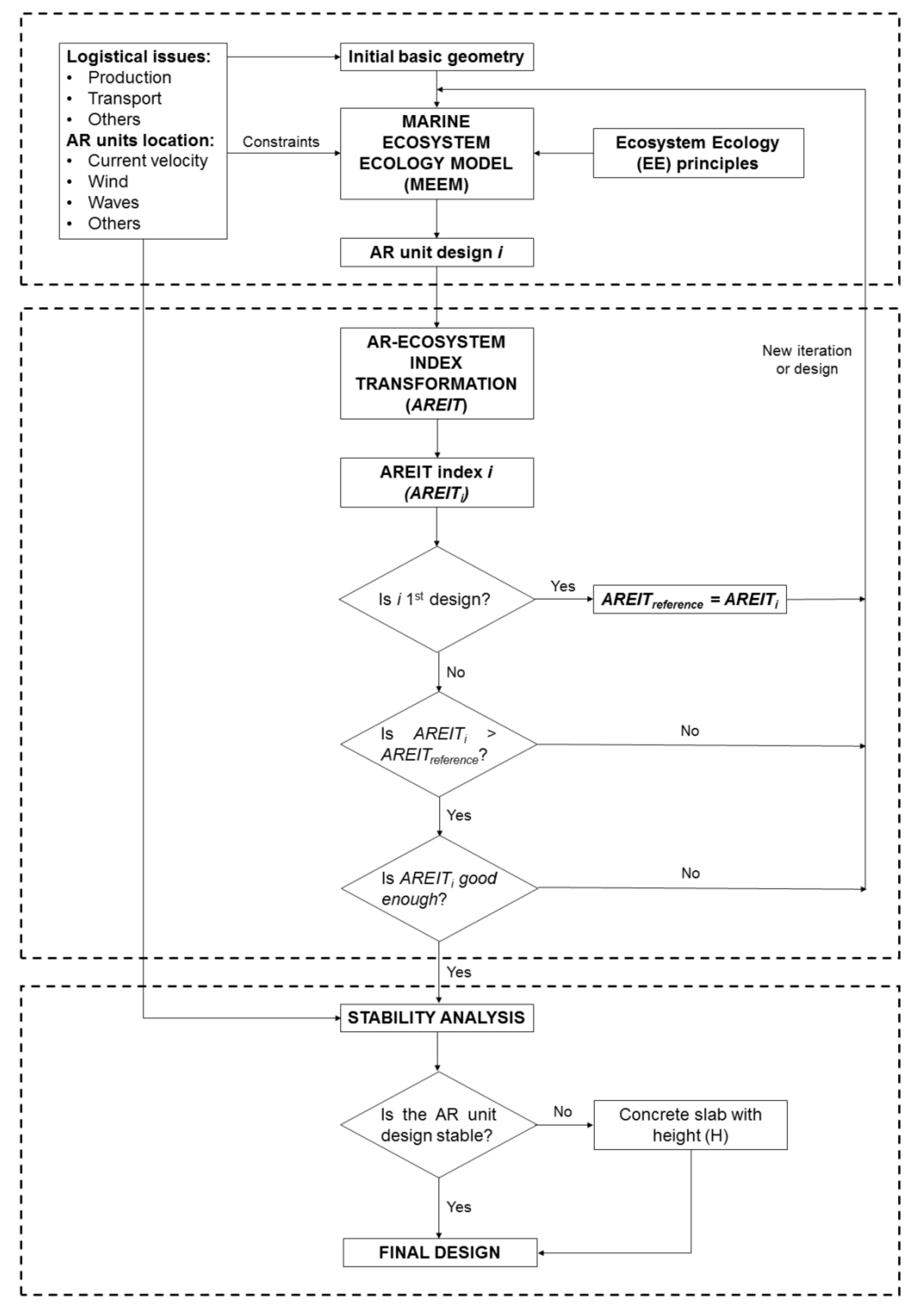
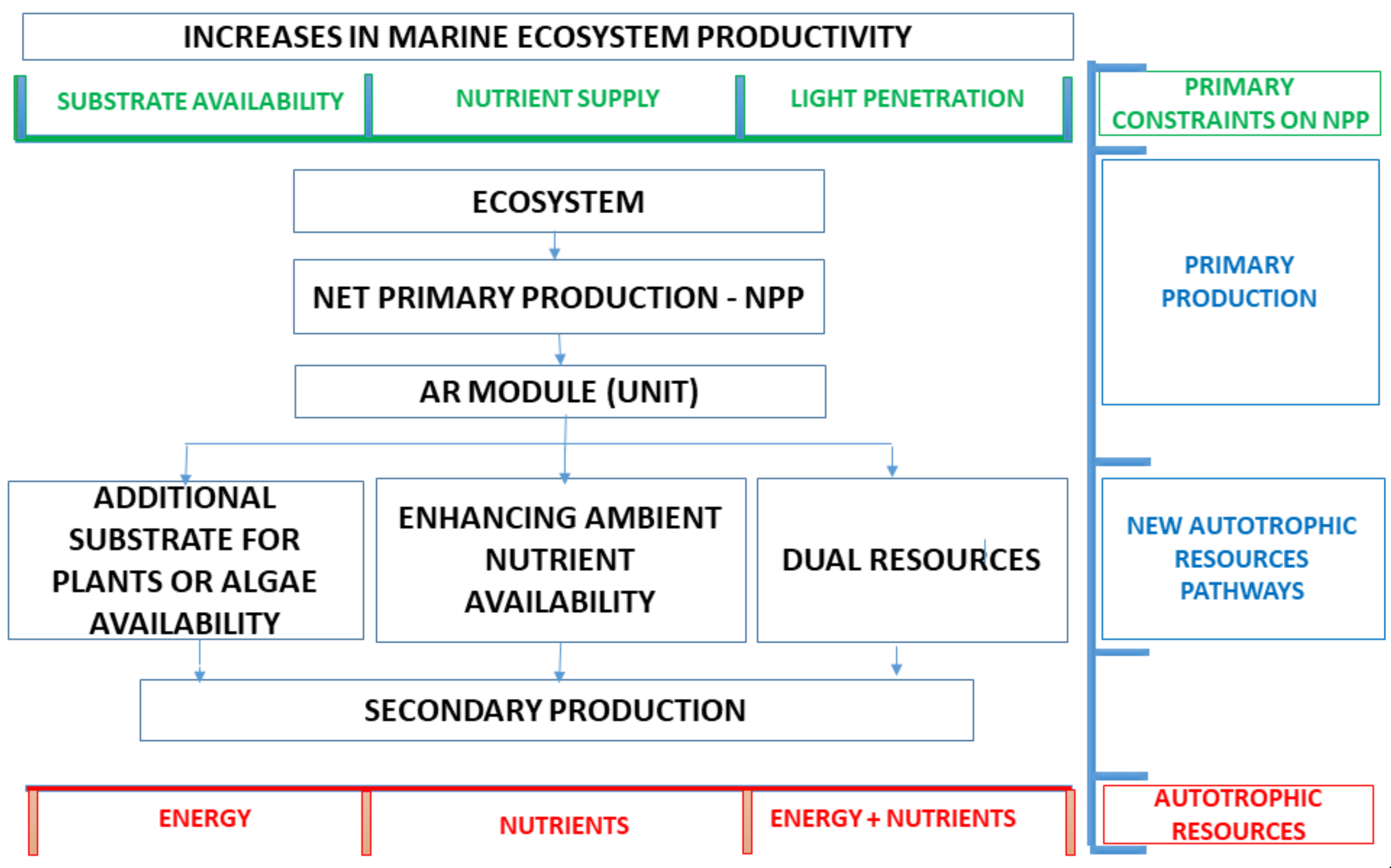

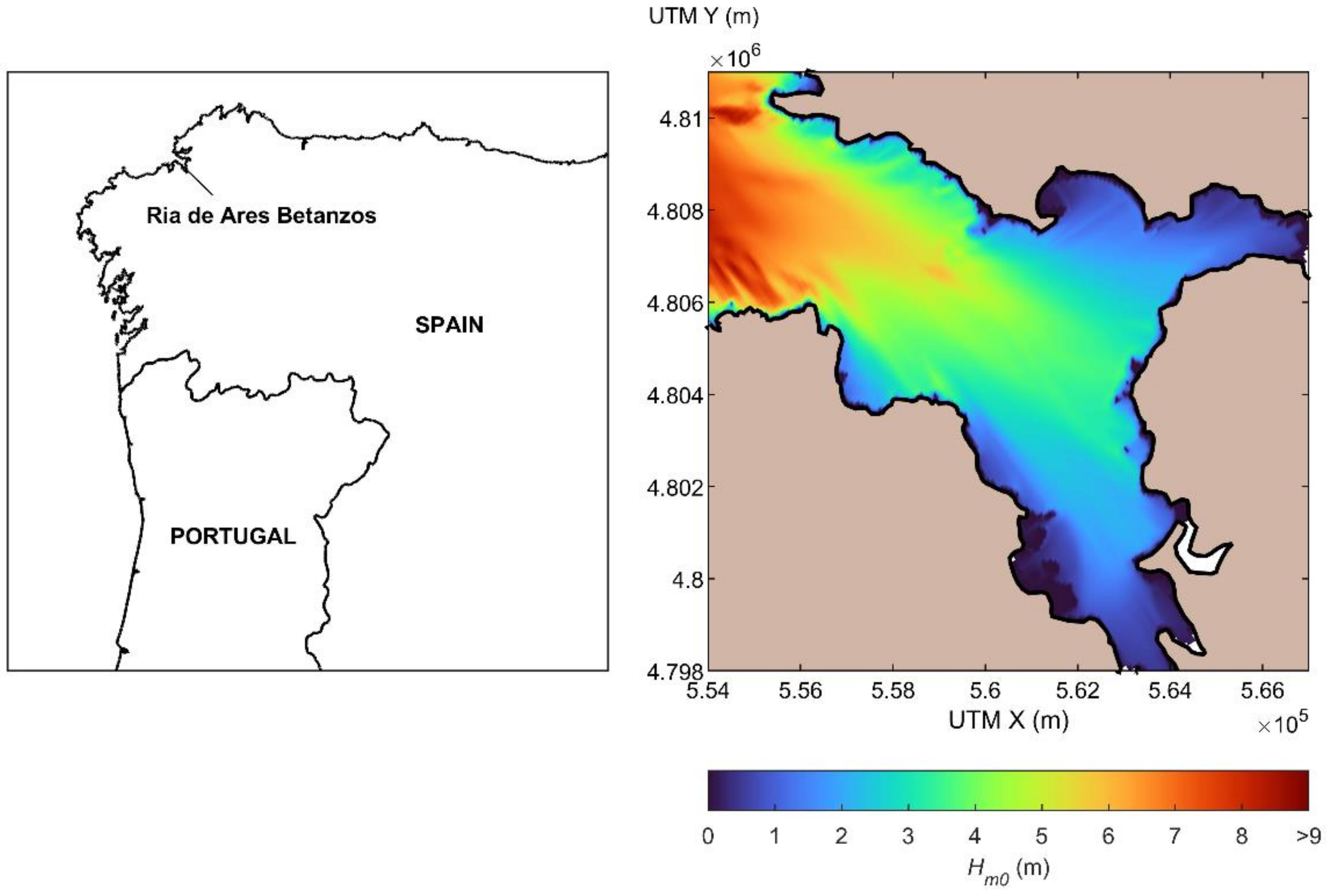

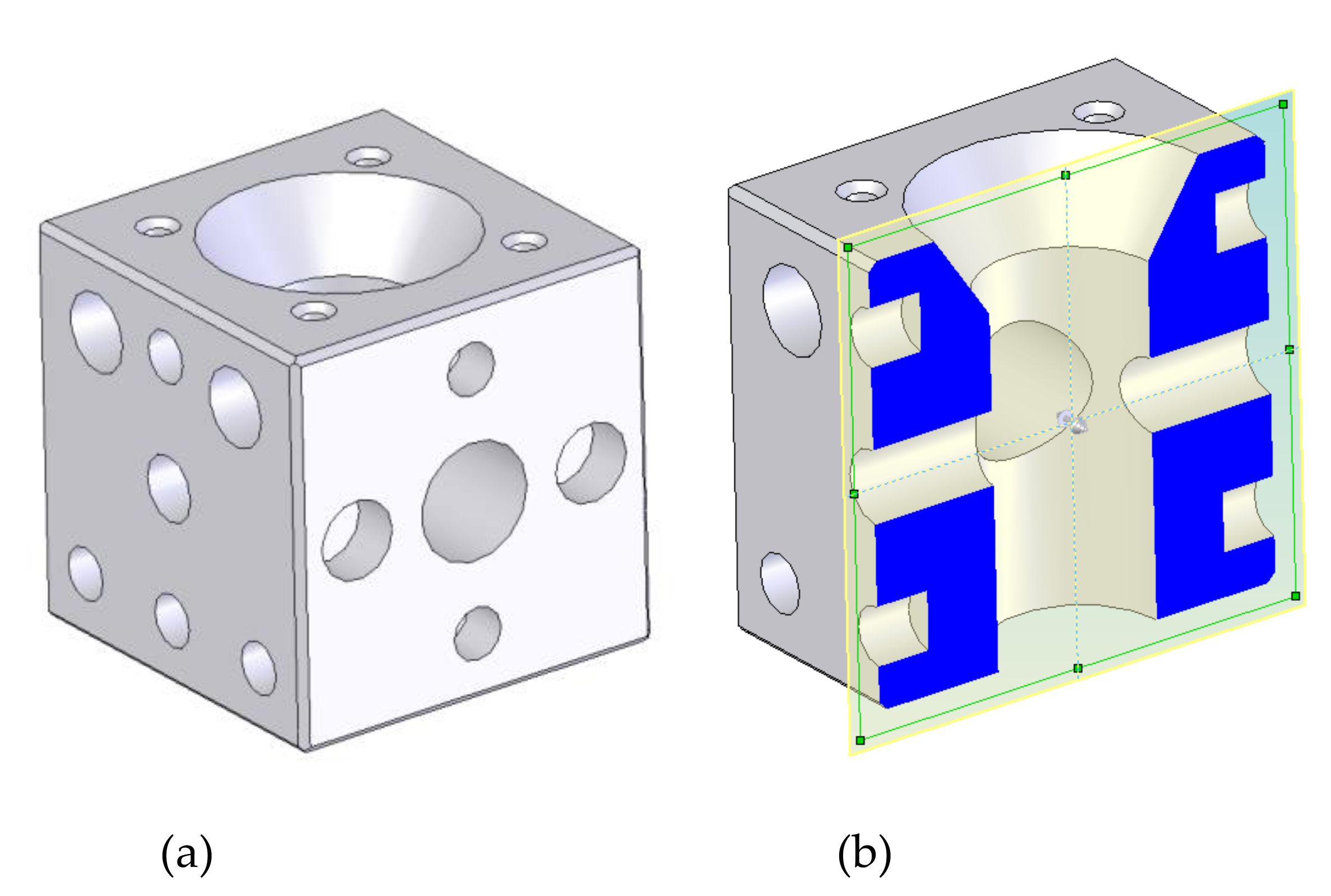
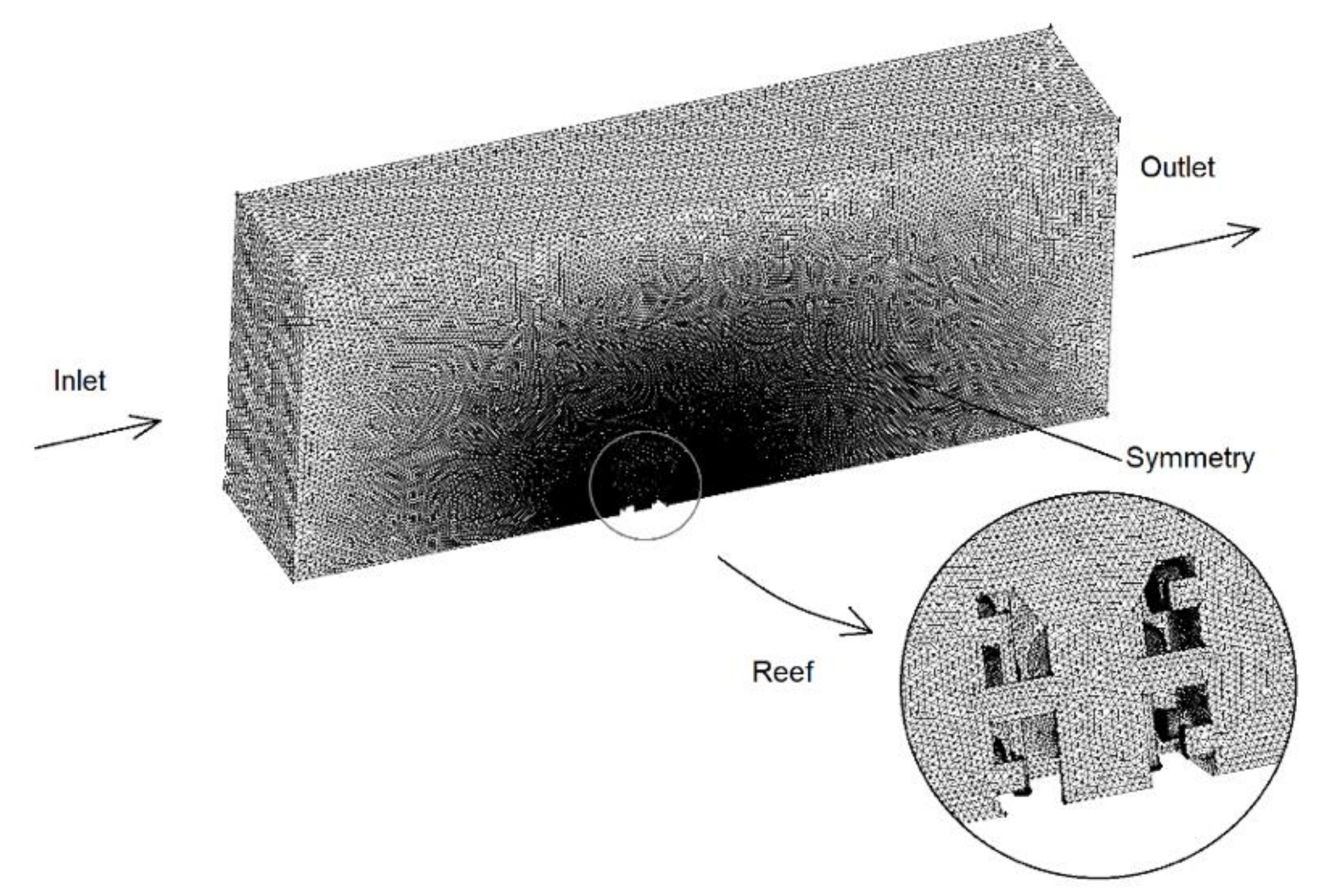

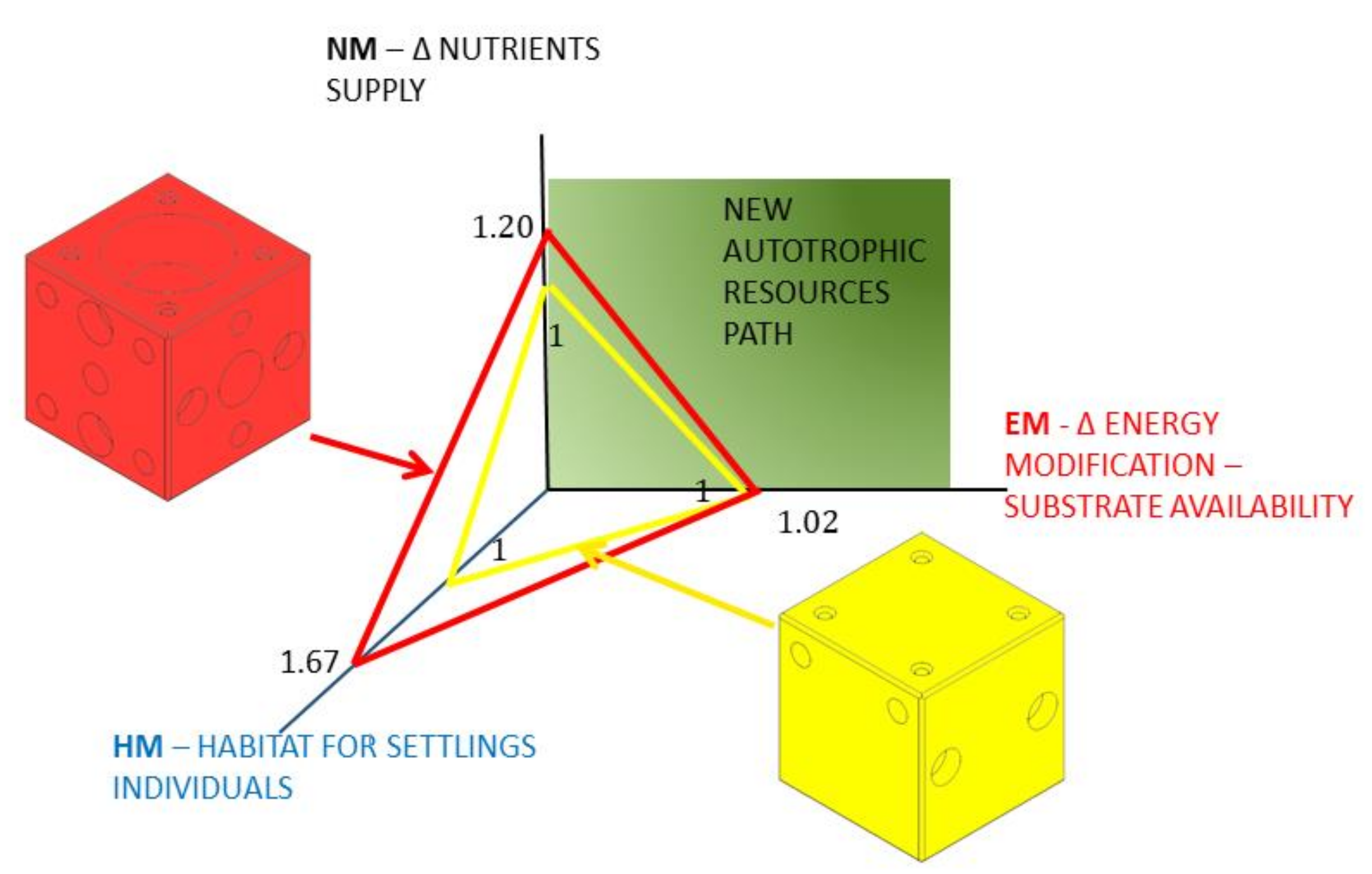
| Type of Factor | General Pathways | Physical Parameters | New Autotrophic Resource Pathways |
|---|---|---|---|
| Source | Bohnsack [43] | Charbonnel et al. [44], Barnabé et al. [45], Allemand et al. [46] | Layman and Allgeier [8] |
| Correlation among determinants | Providing additional food | Area, material, roughness, upper central hole | Additional substrate for algae and plants availability |
| Increasing feeding efficiency | Verticality, lateral vertical holes | Enhancing ambient nutrient availability | |
| Providing more shelter | Nest cavities (shape) | ||
| Providing recruitment habitat for settling individuals | Nest cavities (size and number) |
| Determinant Factors | MEEM Model Foundations | ||||
|---|---|---|---|---|---|
| Energy | Nutrients | Habitat for Settling Individuals | |||
| General Parameters | Specific Parameters | Substrate Availability | Light Supply | Nutrient Supply | |
| Material | AR material type | ✓ | - | - | - |
| Material pH | ✓ | - | - | - | |
| Roughness | ✓ | - | - | - | |
| Area | Area | ✓ | - | - | ✓ |
| Shape | Verticality | ✓ | X | ✓ | - |
| Upper central hole | - | ✓ | - | - | |
| Lateral holes | X | - | ✓ | - | |
| Nest cavities | Nest cavities (size) | - | - | - | ✓ |
| Nest cavities (type) | - | - | - | ✓ | |
| Nest cavities number | - | - | - | ✓ | |
| ✓: Positive impact | |||||
| X: Negative impact | |||||
| -: No impact | |||||
| Relevant Information and Main Parameters | Basic Design | Final Design |
|---|---|---|
| General information | 4 vertical faces 8 nest cavities (30 cm diameter) | 4 vertical inner faces with lateral holes 4 vertical outer faces with lateral holes 1 horizontal inner face with the upper central hole 12 nest cavities (20 cm diameter) 8 nest cavities (30 cm diameter) |
| EM parameters | ||
| NM parameters | ||
| HM parameters |
Publisher’s Note: MDPI stays neutral with regard to jurisdictional claims in published maps and institutional affiliations. |
© 2022 by the authors. Licensee MDPI, Basel, Switzerland. This article is an open access article distributed under the terms and conditions of the Creative Commons Attribution (CC BY) license (https://creativecommons.org/licenses/by/4.0/).
Share and Cite
Carral, L.; Lamas, M.I.; Cartelle Barros, J.J.; López, I.; Carballo, R. Proposed Conceptual Framework to Design Artificial Reefs Based on Particular Ecosystem Ecology Traits. Biology 2022, 11, 680. https://doi.org/10.3390/biology11050680
Carral L, Lamas MI, Cartelle Barros JJ, López I, Carballo R. Proposed Conceptual Framework to Design Artificial Reefs Based on Particular Ecosystem Ecology Traits. Biology. 2022; 11(5):680. https://doi.org/10.3390/biology11050680
Chicago/Turabian StyleCarral, Luis, María Isabel Lamas, Juan José Cartelle Barros, Iván López, and Rodrigo Carballo. 2022. "Proposed Conceptual Framework to Design Artificial Reefs Based on Particular Ecosystem Ecology Traits" Biology 11, no. 5: 680. https://doi.org/10.3390/biology11050680
APA StyleCarral, L., Lamas, M. I., Cartelle Barros, J. J., López, I., & Carballo, R. (2022). Proposed Conceptual Framework to Design Artificial Reefs Based on Particular Ecosystem Ecology Traits. Biology, 11(5), 680. https://doi.org/10.3390/biology11050680










